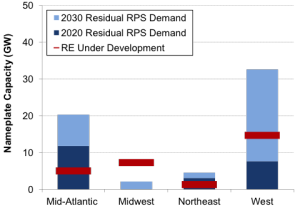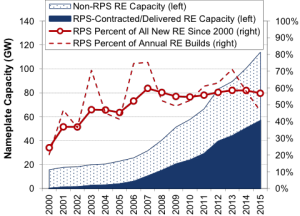Berkeley, CA —State renewables portfolio standards, known as RPS policies, have contributed to more than half of all renewable electricity growth in the United States since 2000. Most state RPS requirements will continue to rise through at least 2020, if not beyond, and collectively these policies will require substantial further growth in U.S. renewable electricity supplies. These findings, illustrated in the figures below, are part of a new annual status report on state RPS policies, from Lawrence Berkeley National Laboratory (Berkeley Lab).
The status report—published in slide-deck form and entitled U.S. Renewables Portfolio Standards: 2016 Annual Status Report—provides a data-intensive review of state RPS policies, highlighting recent legislative revisions, key policy design features, past and projected impacts on renewables development, compliance trends, and costs.
“This document is intended as a progress report to help policy-makers and other electricity industry participants understand the past and future role of state RPS programs—recognizing that they are but one of a number of key drivers affecting renewable energy development in the United States,” said Berkeley Lab’s Galen Barbose, the report’s author.
RPS-Driven Renewables Capacity Growth (left) and Residual RPS Demand (right)
Mandatory RPS policies require utilities or other electricity providers to generate a minimum portion of their supply from eligible forms of renewable electricity or renewable electricity certificates. They currently exist in 29 U.S. states plus Washington, D.C., and have been a cornerstone of renewable electricity policy in the United States over the past decade. Additional states have voluntary renewable electricity goals.
Key trends highlighted in the report include the following:
- Recent Legislative Revisions: In total, almost 150 RPS-related bills have been introduced since the beginning of 2015, split roughly evenly between those that would strengthen, weaken, or have a neutral impact on RPS requirements. Significant legislation enacted in the past year includes new or expanded RPS policies in California, Hawaii, Oregon, and Vermont, while Kansas replaced its RPS with a voluntary goal. Regulators in New York are also in the process of expanding the state’s RPS.
- Historical Impacts on Renewables Development: More than half of all growth in U.S. renewable electricity generation (60%) and capacity (57%) since 2000 can be associated with state RPS requirements, though other drivers also undoubtedly contributed to this growth (see infographic). The relative contribution of RPS programs to overall renewable energy growth has declined in recent years as other drivers—such as corporate procurement and projects developed for merchant power sales—have become more significant. Although wind energy has been the predominant share (64%) of all RPS-driven capacity growth to-date, solar energy was by far the largest source (69%) of new RPS builds in 2015.
- Growing RPS Demand: Five states reached the terminal year of their RPS in 2015, and most others will do so by 2025. Nevertheless, total RPS-driven demand for renewable energy will double from 215 terawatt-hours (TWh) in 2015 to 431 TWh in 2030. To match this growth, total non-hydroelectric renewables in the United States would need to reach 12.1% of electricity sales by 2030, up from roughly 8% today (see infographic), though actual growth may be greater or less than this amount. This comparison focuses on non-hydroelectric renewable electricity, because most RPS rules allow only limited forms hydroelectric generation to be used for compliance.
- Projected Future Impact on Renewables Development: Relative to currently available renewable energy supply, increasing RPS demand could require an additional 60 gigawatts (GW) of primarily non-hydroelectric renewables capacity by 2030, beyond the 114 GW of capacity installed as of year-end 2015 (see infographic). Current build-rates are on pace to meet those requirements, with roughly 6 GW of non-hydroelectric renewable generation capacity added for RPS requirements in 2015.
- Achievement of Interim RPS Targets: RPS requirements have thus far largely been met fully with renewable energy purchases, with states collectively meeting roughly 95% of their interim RPS targets in recent years (see infographic). Achievement of solar and distributed generation carve-outs has been somewhat lower, though still relatively high, with states meeting 87% of recent interim targets, on average.
- Compliance Costs: RPS compliance costs totaled roughly $2.6 billion in 2014 (the most recent year with available data), averaging $12 per megawatt-hour of renewable electricity. These costs equate to 1.3% of average consumer electricity bills in 2014, up from 1.0% of average electricity bills in 2013 (see infographic). Growth in compliance costs going forward will be capped in most RPS states by cost containment mechanisms of various types. A separate Berkeley Lab study released earlier this year quantified benefits associated with state RPS policies.
The status report draws on regulatory filings and other public data sources, and is an extension of Berkeley Lab’s ongoing efforts to track and analyze state RPS policies.
This publication and other related resources—including data files, prior reports, presentations, and webinar recordings—are freely available through Berkeley Lab’s RPS webpage: rps.lbl.gov.
This research was supported by the National Electricity Delivery Division of the Office of Electricity Delivery and Energy Reliability of the U.S. Department of Energy.
# # #
The Electricity Markets and Policy Group at Berkeley Lab conducts technical, economic, and policy analysis of energy topics centered on the U.S. electricity sector. Our current research seeks to inform public and private decision-making on public-interest issues related to energy efficiency and demand response, renewable energy, electricity resource and transmission planning, and electricity reliability. For more information, please visit emp.lbl.gov and follow us on Twitter at @BerkeleyLabEMP.
Lawrence Berkeley National Laboratory addresses the world’s most urgent scientific challenges by advancing sustainable energy, protecting human health, creating new materials, and revealing the origin and fate of the universe. Founded in 1931, Berkeley Lab’s scientific expertise has been recognized with 13 Nobel prizes. The University of California manages Berkeley Lab for the U.S. Department of Energy’s Office of Science. For more information, please visit www.lbl.gov.
DOE’s Office of Science is the single largest supporter of basic research in the physical sciences in the United States, and is working to address some of the most pressing challenges of our time. For more information, please visit science.energy.gov.


